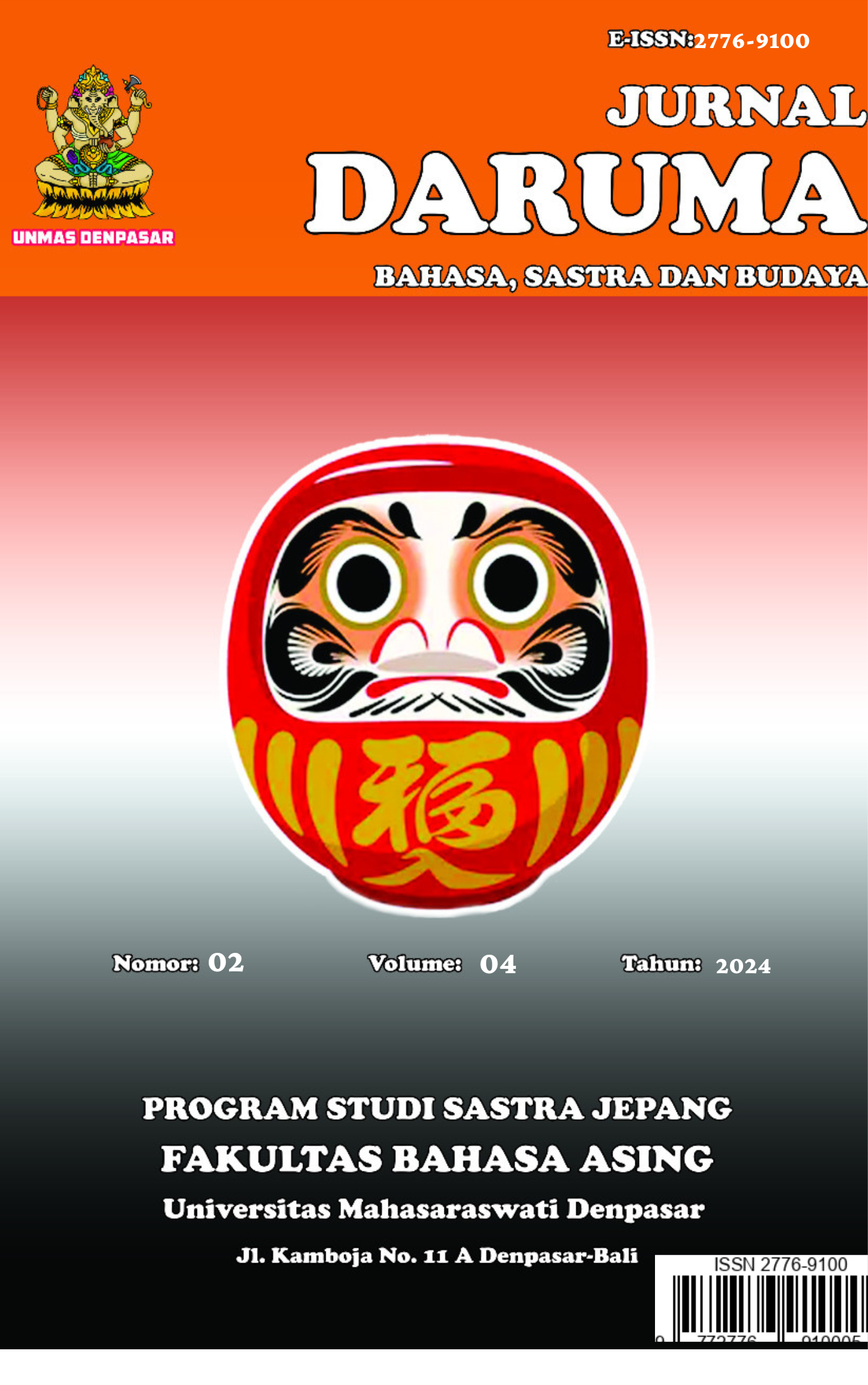GAYA BAHASA SINESTESIA PADA LIRIK LAGU BAHASA JEPANG MASA KINI
Gaya Bahasa Sinestesia
Keywords:
language style; synesthesia; majasAbstract
ABSTRACT
The study entitled "The Use of Synesthesia Language Style in Today's Japanese Song Lyrics": aims to describe and examine the meaning of synesthesia used in Japanese song lyrics since the last thirteen years, starting from 2010 to 2023. Through the distributional study method, the author collects data through note-taking techniques. Synesthesia is an expression phenomenon used for one type of sensation (sense) to another sensation observed through various types of human senses. A song is music, which is rhythmic, melodic, harmonious. The composer usually expresses his thoughts and feelings in such a way that they merge in a whole. Data sources Japanese song lyrics are then divided into two categories, namely romance theme songs and life themes. Synesthesia is categorized as romance as in the song「こんな甘い痛みがこの世界にあるなんて」tells the story of 'the pain that really exists in this world'. The singer seems to express that he feels a very sweet pain because he keeps thinking about his sweetheart and wants to continue to pursue him, through the category of synesthetic life This lyric also means 「苦い青春を捨てても、行こう」The use of the word 苦い nigai or bitter in 苦い青春 nigai seishun, i.e. bitter youth, can be understood as something displeased, distressed, and sad.
References
Chaer, Abdul. (2007). Linguistik Umum. Jakarta: Rineka Cipta.
Damayanti, R. (2018). Diksi dan Gaya Bahasa Dalam Media Sosial Instagram. Jurnal Widyaloka Ikip Widya Darma, 5(3), 267.
Jamalus. (1988). Panduan Pengajaran Buku Pengajaran Musik Melalui Pengalaman Musik. Jakarta: Proyek Pengembangan Lembaga Pendidikan.
Keraf, Gorys.(2010). Diksi dan Gaya Bahasa. Jakarta: Gramedia Pustaka Umum.
Kridalaksana, Harimurti. (2008). Kamus Linguistik Edisi Keempat. Jakarta: Gramedia Pustaka Utama.
Kushartanti. (2005). Pesona Bahasa (Langkah Awal Memahami Linguistik). Jakarta: Gramedia Pustaka Utama.
Morishita, Mitsuru. (2018). Gaien to Naihou no Teigi ni Kanrenshite. Hokkaido: Obihiru.
Nazir, Mohammad. (2013). Metode Penelitian. Bogor: Ghalia Indonesia.
Parera, J. D. (2004). Teori Semantik. Jakarta: Penerbit Erlangga.
Pateda, Mansoer. (2010). Semantik Leksikal. Jakarta: Rineka Cipta.
Pradopo, Rahmat Djoko. (2002). Pengkajian Puisi. Yogyakarta: Gadjah Mada University Press.
Putra, Dhanu Ario. (2017). Analisis Kualitas Terjemahan Terhadap Istilah-istilah Teknis di dalam Game Ragnarok Online Karya Gravity. Prasasti: Journal of Linguistics, 2, 1.
Raco, Jozef. (2010). Metode Penelitian Kualitatif: Jenis, Karakteristik, dan Keunggulannya. Jakarta: Grasindo.
Ratna, Nyoman K. (2009). Stilistika: Kajian Puitika Bahasa, Sastra, dan Budaya. Yogyakarta: Pustaka Pelajar.
Teeuw, A. (1984). Sastra dan Ilmu Sastra: Pengantar Teori Sastra. Jakarta: Dunia Pustaka Jaya.
Tarigan, Henry Guntur. (2013). Pengajaran Gaya Bahasa. Bandung: Angkasa.
Waridah, Ernawati. (2014). Kumpulan Majas, Pantun, dan Peribahasa Plus Kesusastraan Indonesia. Jakarta Selatan: Kawan Pustaka.
Yoshihiko, Ikegami. (1975). Imiron: Imi Kouzou no Bunseki to Kijutsu. Japan: Taishuukan Shoten.
Zaim, M. (2014). Metode Penelitian Bahasa: Pendekatan Struktural. Padang: FBS UNP Press





